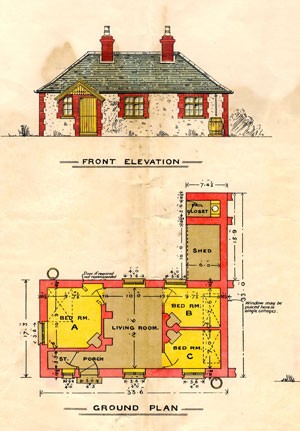KINDRED LINES: ARTISANS’ AND LABOURERS’ COTTAGES
Published in Features, Issue 1 (January/February 2023), Volume 31By Fiona Fitzsimons

Above: Plan of a labourer’s cottage c. 1900 from the Rural Districts Council Collection. (Donegal County Archives)
In 1831 the Board of Public Works was established by a parliamentary act. It assumed the powers of several pre-existing bodies, combining them into one. The Board had permanent powers and a range of concerns beyond those of its English counterpart. It could set up relief projects, for example, including public work schemes for subsistence relief. It was responsible for civil buildings, piers and fisheries, royal harbours and inland navigation, among other things. It paid for major infrastructure projects out of the public purse. It provided grants and loans for smaller-scale local development.
In the second half of the nineteenth century, the Board continued to lend money for construction, including houses for the labouring and working classes. The relevant legislation included the following.
- Landed Property (Ireland) Improvement Act, 1860, 23 Vic. c.19: enabled the Board to make loans to facilitate landowners to build houses for ‘Stewards, Labourers or other persons employed in … cultivating land’.
- Labouring Classes Lodging Houses and Dwellings (Ireland) Act, 1866, 29 Vic. c.4: authorised the Board to lend money to town councils, railway companies, harbour commissioners, manufacturing companies and landowners to buy sites, and to build or adapt existing buildings for workers.
- Artisans and Labourers Dwellings Improvement Act, 1875, 38 & 39 Vic. c.36: encouraged slum clearance by mainly urban sanitary authorities (Poor Law Unions). The Act allowed for the compulsory purchase of land, and its commercial redevelopment, to provide affordable housing for workers in full-time employment. Between 1880 and 1908 the Dublin Artisans Dwelling Company built over 3,300 houses. About one in four unions developed artisanal companies for housing. Plans are deposited by county and union.
- Labourers (Ireland) Acts 1883, 1885: encouraged rural local authorities to improve their housing stock, using public land as well as by facilitating compulsory purchase of sites. Houses were built on the roadsides with a small allotment, typically half an acre, attached. Between 1883 and 1914 nearly 50,000 new houses were built.
- 1890 Housing of the Working Classes Act, 46 & 47 Vic. c.60, 48 & 49 Vic. c.77: enabled the Board to authorise loans to individuals or local authorities who could show a need for housing in their district. Under the legislation, the newly constituted Local Government Board vetted all applications. If the application met all the criteria, it was sent to the Board of Works for approval. The Act also gave local authorities the legal power to buy land and to construct tenements and housing estates.
The number of fourth-class houses, essentially the traditional thatched mud cabins, fell from 135,589 (or 12.96% of all housing) in 1851 to 9,873 (or 1.15%) by 1901.
The archives of the Office of Public Works (OPW), successor of the Board of Works, is deposited in the National Archives. Files include site and boundary maps, drawings and floorplans, and specifications of the materials and costs of building.
If you are searching for an individual or family after 1844, cross-reference the earlier Valuation Office Archives with the OPW’s housing records.
Fiona Fitzsimons is a director of Eneclann, a Trinity campus company, and of findmypast Ireland.
















